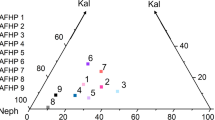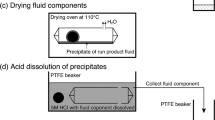Abstract
The electrical conductivity of aqueous fluids containing 0.01, 0.1, and 1 M NaCl was measured in an externally heated diamond cell to 600 °C and 1 GPa. These measurements therefore more than double the pressure range of previous data and extend it to higher NaCl concentrations relevant for crustal and mantle fluids. Electrical conductivity was generally found to increase with pressure and fluid salinity. The conductivity increase observed upon variation of NaCl concentration from 0.1 to 1 M was smaller than from 0.01 to 0.1 M, which reflects the reduced degree of dissociation at high NaCl concentration. Measured conductivities can be reproduced (R 2 = 0.96) by a numerical model with log \(\sigma\) = −1.7060– 93.78/T + 0.8075 log c + 3.0781 log \(\rho\) + log \(\varLambda\) 0(T, \(\rho\)), where \(\sigma\) is the conductivity in S m−1, T is temperature in K, c is NaCl concentration in wt%, \(\rho\) is the density of pure water (in g/cm3) at given pressure and temperature, and \(\varLambda\) 0 (T, \(\rho\)) is the molar conductivity of NaCl in water at infinite dilution (in S cm2 mol−1), \(\varLambda\) 0 = 1573–1212 \(\rho\) + 537 062/T–208 122 721/T 2. This model allows accurate predictions of the conductivity of saline fluids throughout most of the crust and upper mantle; it should not be used at temperatures below 100 °C. In general, the data show that already a very small fraction of NaCl-bearing aqueous fluid in the deep crust is sufficient to enhance bulk conductivities to values that would be expected for a high degree of partial melting. Accordingly, aqueous fluids may be distinguished from hydrous melts by comparing magnetotelluric and seismic data. H2O–NaCl fluids may enhance electrical conductivities in the deep crust with little disturbance of v p or v p/v s ratios. However, at the high temperatures in the mantle wedge above subduction zones, the conductivity of hydrous basaltic melts and saline aqueous fluids is rather similar, so that distinguishing these two phases from conductivity data alone is difficult. Observed conductivities in forearc regions, where temperatures are too low to allow melting, may be accounted for by not more than 1 wt% of an aqueous fluid with 5 wt% NaCl, if this fluid forms a continuous film or fills interconnected tubes.








Similar content being viewed by others
References
Atkins PW (1982) Physical chemistry. Oxford University Press, Oxford
Audetat A, Keppler H (2004) Viscosity of fluids in subduction zones. Science 303:513–516
Bassett WA, Shen AH, Bucknum M, Chou IM (1993) A new diamond anvil cell for hydrothermal studies to 2.5 GPa and from −190 °C to 1200 °C. Rev Sci Instrum 64:2340–2345
Burnham CW, Holloway JR, Davis NF (1969) Thermodynamic properties of water to 1000 °C and 10000 bars. Geol Soc Am Spec Pap 132:1–96
Chen L, Booker JR, Jones AG, Wu N, Unsworth MJ, Wei W, Tan H (1996) Electrically conductive crust in southern Tibet from INDEPTH magnetotelluric surveying. Science 274:1694–1696
Cruz MF, Manning CE (2015) Experimental determination of quartz solubility and melting in the system SiO2–H2O–NaCl at 15–20 kbar and 900–1100 °C: implications for silica polymerization and the formation of supercritical fluids. Contrib Mineral Petrol 170:35
Fogo JK, Benson SW, Copeland CS (1954) The electrical conductivity of supercritical solutions of sodium chloride and water. J Chem Phys 22:212–216
Franck EU (1956) Hochverdichteter Wasserdampf I. Elektrolytische Leitfähigkeit in KCl–H2O–Lösungen bis 750 °C. Z Phys Chem 8:92–106
Frezzotti ML, Ferrando S (2015) The chemical behavior of fluids released during deep subduction based on fluid inclusions. Am Mineral 100:352–377
Gaillard F (2004) Laboratory measurements of electrical conductivity of hydrous and dry silicic melts under pressure. Earth Planet Sci Lett 218:215–228
Gaillard F, Scaillet B, Pichavant M (2004) Evidence for present-day leucogranite pluton growth in Tibet. Geology 32:801–804
Guo X, Yoshino T, Shimojuku A (2015) Electrical conductivity of albite–(quartz)–water and albite–water–NaCl systems and its implication to the high conductivity anomalies in the continental crust. Earth Planet Sci Lett 412:1–9
Hacker BR (2008) H2O subduction beyond arcs. Geochem Geophys Geosyst 9:Q03001. doi:10.1029/2007GC001707
Hashim L, Gaillard F, Champallier R, LeBreton N, Arbaret L, Scaillet B (2013) Experimental assessment of the relationships between electrical resistivity, crustal melting and strain localization beneath the Himalayan–Tibetan belt. Earth Planet Sci Lett 373:20–30
Hashin Z, Shtrikman S (1962) A variational approach to the theory of the effective magnetic permeability of multiphase materials. J Appl Phys 33:3125–3131
Hoffmann-Rothe A, Ritter O, Haak V (2001) Magnetotelluric and geomagnetic modelling reveals zones of very high electrical conductivity in the upper crust of central Java. Phys Earth Planet Inter 124:131–151
Holzapfel WB (1969) Effect of pressure and temperature on the conductivity and ionic dissociation of water up to 100 kbar and 1000 °C. J Chem Phys 50:4424–4428
Holzapfel W, Franck EU (1966) Leitfähigkeit und Ionendisoziation des Wassers bis 1000 °C und 100 kbar. Ber Bunsenges Phys Chem 70:1105–1112
Ichiki M, Ogawa Y, Kaida T, Koyama T, Uyeshima M, Demachi T, Hirahara S, Honkura Y, Kanda W, Kono T, Matsushima M, Nakayama T, Syuichi Suzuki S, Toh H (2015) Electrical image of subduction zone beneath northeastern Japan. J Geophys Res 120:7937–7965
Irifune T, Kurio A, Sakamoto S, Inoue T, Sumiya H (2003) Materials—ultrahard polycrystalline diamond from graphite. Nature 421:599–600
Jolliffe CB (1923) A study of polarization capacity and resistance at radio frequencies. Phys Rev 22:293–302
Jones G, Christian SM (1935) The measurement of the conductance of electrolytes. VI. Galvanic polarization by alternating current. J Am Chem Soc 57:272–280
Kawamoto T, Yoshikawa M, Kumagai Y, Mirabueno MHT, Okuno M, Kobayashi T (2013) Mantle wedge infiltrated with saline fluids from dehydration and decarbonation of subducting slab. Proc Nat Acad Sci USA 110:9663–9668
Keppler H (2017) Fluids and trace element transport in subduction zones. Am Mineral 102 (in press)
Laumonier M, Gaillard F, Sifre D (2015) The effect of pressure and water concentration on the electrical conductivity of dacitic melts: implication for magnetotelluric imaging in subduction areas. Chem Geol 418:66–76
Le Pape F, Jones AG, Vozar J, Wenbo W (2012) Penetration of crustal melt beyond the Kunlun Fault into northern Tibet. Nat Geosci 5:330–335
Mangold K, Franck EU (1969) Elektrische Leitfähigkeit wäßriger Lösungen bei hohen Temperaturen und Drucken. II Alkalichloride in Wasser bis 1000 °C und 12 kbar. Ber Bunsenges Phys Chem 73:21–27
Manzella A, Volpi G, Zaja A, Meju M (2004) Combined TEM-MT investigation of shallow-depth resistivity structure of Mt Somma-Vesuvius. J Volcanol Geothermal Res 131:19–32
Marshall WL, Franck EU (1981) Ion product of water substance, 0–1000 °C, 1–10000 bars. New international formulation and its background. J Phys Chem Ref Data 10:295–304
Marshall WL, Frantz JD (1987) Electrical conductance measurements of dilute, aqueous electrolytes at temperatures to 800 °C and pressures to 4000 bars: techniques and interpretations. In: Ulmer GC, Barnes HL (eds) Hydrothermal experimental techniques. Wiley, New York, pp 261–292
McGary RS, Evans RL, Wannamaker PE, Elsenbeck J, Rondenay J (2014) Pathway from subducting slab to surface for melt and fluids beneath Mount Rainier. Nature 511:338–340
Métrich N, Wallace PJ (2008) Volatile abundances in basaltic magmas and their degassing paths tracked by melt inclusions. Rev Mineral Geochem 69:363–402
Nelson KD, Zhao W, Brown LD, Kuo J, Che J, Liu X, Klemperer SL, Makovsky Y, Meissner R, Mechie J, Kind R, Wenzel F, Ni J, Nabelek J, Leshou C, Tan H, Wei W, Jones AG, Booker J, Unsworth M, Kidd WSF, Hauck M, Alsdorf D, Ross A, Cogan M, Wu C, Sandvol E, Edwards M (1996) Partially molten middle crust beneath Southern Tibet: synthesis of project INDEPTH results. Science 274:1684–1688
Nesbitt BE (1993) Electrical resistivities of crustal fluids. J Geophys Res 98:4301–4310
Ni H, Chen Q (2014) Electrical conductivity measurements of aqueous fluids under pressure with a hydrothermal diamond anvil cell. Rev Sci Instrum 85(11):115107
Ni H, Keppler H, Behrens H (2011a) Electrical conductivity of hydrous basaltic melts: implications for partial melting in the upper mantle. Contrib Mineral Petrol 162:637–650
Ni H, Keppler H, Manthilake MAGM, Katsura T (2011b) Electrical conductivity of dry and hydrous NaAlSi3O8 glasses and liquids at high pressures. Contrib Mineral Petrol 162:501–513
Pham VN, Boyer D, There P, Yuan XC, Li L, Jin GY (1986) Partial melting zones in the crust of southern Tibet from magnetotelluric results. Nature 319:310–314
Pitzer KS, Sterner SM (1994) Equations of state valid continuously from zero to extreme pressures for H2O and CO2. J Chem Phys 101:3111–3116
Pommier A (2014) Geophysical assessment of migration and storage conditions of fluids in subduction zones. Earth, Planets and Space 66: Article number 38
Pommier A, Gaillard F, Pichavant M, Scaillet B (2008) Laboratory measurements of electrical conductivities of hydrous and dry Mount Vesuvius melts under pressure. J Geophys Res 113:B05205. doi:10.1029/2007JB005269
Quist AS (1970) The ionization constant of water to 800 °C and 4000 bars. J Phys Chem 74:3396–3402
Quist AS, Marshall WL (1968) Electrical conductances of aqueous sodium chloride solutions from 0 to 800 ˚ and at pressures to 4000 bars. J Phys Chem 72:684–703
Roedder E (1984) Fluid inclusions. In: Reviews in mineralogy, vol 12. Mineralogical Society of America, Washington, DC, pp 1–644
Sakuma H, Ichiki M (2016) Electrical conductivity of NaCl–H2O fluid in the crust. J Geophys Res Solid Earth. doi:10.1002/2015JB012219
Schmeling H (1985) Numerical models on the influence of partial melt on elastic, anelastic and electric properties of rocks. Part I: elasticity and anelasticity. Phys Earth Planet Inter 41:34–57
Schmeling H (1986) Numerical models on the influence of partial melt on elastic, anelastic and electrical properties of rocks. Part II: electrical conductivity. Phys Earth Planet Inter 43:123–136
Schmidt MW, Vielzeuf D, Auzanneau E (2004) Melting and dissolution of subducting crust at high pressures: the key role of white mica. Earth Planet Sci Lett 228:65–84
Schmidt C, Steele-MacInnis M, Watenphul A, Wilke M (2013) Calibration of zircon as a Raman spectroscopic pressure sensor to high temperatures and application to water-silicate melt systems. Am Mineral 98:643–650
Shimojuku A, Yoshino T, Yamazaki D (2014) Electrical conductivity of brine-bearing quartzite at 1 GPa: implications for fluid content and salinity of the crust. Earth Planet Space 66:2
Sterner SM, Hall DL, Keppler H (1995) Compositional re-equilibration of fluid inclusions in quartz. Contrib Mineral Petrol 119:1–15
Waff H (1974) Theoretical considerations of electrical conductivity in a partially molten mantle and implications for geothermometry. J Geophys Res 79:4003–4010
Worzewski T, Jegen M, Kopp H, Brasse H, Castillo WT (2010) Magnetotelluric image of the fluid cycle in the Costa Rican subduction zone. Nat Geosci 4:108–111
Wynn J, Mosbrucker J, Pierce H, Spicer K (2016) Where is the hot rock and where is the ground water—using CSAMT to map beneath and around Mount St. Helens. J Environm Eng Geophys 21:79–87
Yardley BWD, Bodnar RJ (2014) Fluids in the continental crust. Geochem Perspect 3:1–127
Yardley BWD, Graham JT (2002) The origins of salinity in metamorphic fluids. Geofluids 2:249–256
Acknowledgements
This study was supported by DFG grant Ke 501/ 11-1. Tetsuo Irifune kindly provided the platelets of nanocrystalline diamond via the Joint Usage/Research Center PRIUS at Ehime University, and Petra Buchert converted all the data of Quist and Marshall (1968) into an Excel table for further analysis. Constructive reviews by Fabrice Gaillard and an anonymous referee helped to improve the manuscript.
Author information
Authors and Affiliations
Corresponding author
Additional information
Communicated by Jochen Hoefs.
Electronic supplementary material
Below is the link to the electronic supplementary material.
Rights and permissions
About this article
Cite this article
Sinmyo, R., Keppler, H. Electrical conductivity of NaCl-bearing aqueous fluids to 600 °C and 1 GPa. Contrib Mineral Petrol 172, 4 (2017). https://doi.org/10.1007/s00410-016-1323-z
Received:
Accepted:
Published:
DOI: https://doi.org/10.1007/s00410-016-1323-z




